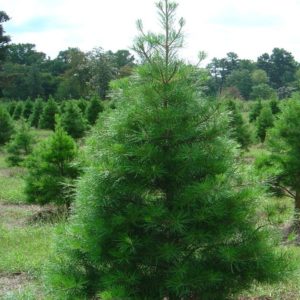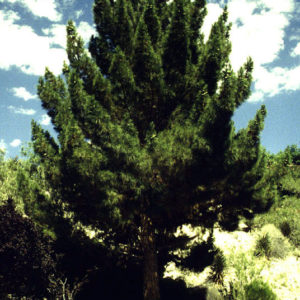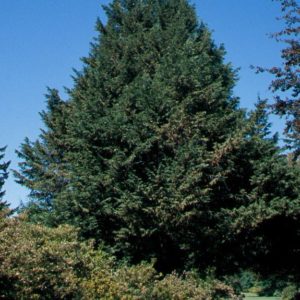A guide for real Christmas trees
A Texas-focused guide to selecting and maintaining real Christmas trees
While Texas probably isn’t the first state most people think of when they ponder where their Christmas trees are grown, the Lone Star State does provide a home for a number of tree types that serve well as the decorative focal point of the holidays.
“Christmas trees typically grow in colder climates with mild summers and cool or cold nights,” said Fred Raley, Ph.D., tree improvement coordinator at the Texas A&M Forest Service’s Forest Science Laboratory, College Station. “But because of our hot, dry summers and warm nights, the Texas climate can only provide a suitable environment to support a limited number of Christmas tree types.”
According to the National Christmas Tree Association, between 25 million and 30 million live Christmas trees are sold annually in the U.S. About 35 different species of trees are grown more specifically for Christmas, with most consumers choosing theirs based on availability, size, shape, needles, branches, fullness and aroma. Balsam, Douglas, Noble and Fraser firs, Scotch pine and Colorado blue spruce are among the most well-known Christmas tree varieties.
“Christmas tree varieties grown in Texas rival many of the better-known trees from other states and provide an equally attractive alternative,” Raley said.
As manager of the forest service’s Virginia pine breeding, testing and seed orchard program, Raley’s work supports the efforts of the Texas Christmas Tree Growers Association, or TCTGA. The association represents more than 120 Texas farmers who grow, sell and promote Texas-grown Christmas trees.
Virginia Pine
Raley said the most common and one of the most popular Christmas trees grown in Texas is the Virginia pine.
“The Virginia pine is a fragrant, short-needled pine with dense foliage and a good shape and branching,” he said. “This particular tree species grows well in the acidic soil of East Texas but can also be grown elsewhere in the state.”
Francis Frederick, TCTGA president, also noted this tree is popular for consumers who prefer to get their trees from choose-and-cut Christmas tree farms.
“This tree also grows well east of Interstate 35 in Texas, and is usually the most selected tree on my farm, Wintergreen Christmas Tree Farm in Van Alstyne, which is a choose-and-cut farm,” he said.
Afghan Pine (Eldarica Pine)
Raley said another type of pine tree, which resembles the Virginia pine and is typically grown in western and central Texas, is the Afghan pine.
“This pine has a mild fragrance and is sturdy like the Virginia pine,” Raley said. “But a notable difference between Afghan and Virginia pine trees is the Afghan’s branches are spread farther apart, giving it a more open appearance.”
Frederick said the Afghan pine is one of the more drought-tolerant Christmas tree varieties and is more suited to grow in the drier areas of Texas, primarily west of Interstate 35.
“This characteristic is particularly useful for Texas Christmas tree farmers who have limited access to water or don’t usually irrigate their trees,” he said.
Eastern Red Cedar
The Eastern red cedar is another more traditional native Christmas tree grown in Texas and the southern U.S.
“Although it has ‘red’ in its name, it is actually a pleasing green color,” Raley said. “The red is a reference to its interior, or heartwood, color. This particular tree is sought out for its agreeable aroma and a natural Christmas tree shape. It also doesn’t have individual needles so much as needle clusters, so there is less individual needle drop.”
“This is one of the rarer trees grown at Texas Christmas tree farms,” Fredericks said. “I’m only aware of a few operations that still grow these as a Christmas tree selection.”
Carolina Sapphire
The Carolina sapphire, a cultivar of the Arizona cypress, is a Christmas tree grown on a limited basis in Texas and throughout the South.
“This variety of tree has a striking blue color and pleasing aroma,” Raley said. “It has a more stocky conical shape and spiral branches of bluish-silver needles. It is also available in different colors, which is probably one of the reasons it seems to be growing in popularity.”
The Carolina sapphire grows better in the more eastern and central parts of Texas, where the soil is a little more acidic, Frederick said.
“This is a fast-growing tree, and its foliage also makes this tree a popular choice for landscaping,” Frederick said. “It also has a pleasant citrus-rosemary scent that makes it appealing to the consumer.”
Leyland Cypress
A Texas-grown Christmas tree selection popular among those with tree pollen allergies is the Leyland cypress.
“This tree is a hybrid of the Alaska cedar and Monterey cypress,” Raley said. “One of its distinguishing characteristics is that it produces no pollen. This Christmas tree variety has a mild aroma and short needles, with dense foliage that give its foliage the appearance of pages in a book.”
The Leyland cypress tends to grow well in black dirt soil and sandy loam soils, Frederick said.
“This tree requires adequate irrigation and is also a popular Christmas tree variety used in landscaping,” Frederick said.
How to plant a Christmas tree for landscaping
Mike Arnold, professor of landscape horticulture with the Texas A&M Department of Horticultural Sciences in the College of Agriculture and Life Sciences, said the five trees noted above can also be used after the holidays for landscaping.
“The Eastern red cedar is probably the most widely adapted for transplanting throughout the state,” Arnold said. “The Virginia pine and Leyland cypress are suited for growing in East Texas landscapes and the Afghan pine and Carolina sapphire generally do well in central and western Texas.”
Arnold said if planning to repurpose a Christmas tree for use in the landscape, it’s best to purchase either a live balled-and-burlap tree or containerized tree less than a week before Christmas and keep it sufficiently watered during its time indoors.
“A cut tree is a dying tree, so don’t try and plant one,” he said. “You’ll want to plant the living tree as soon as possible after the new year, before it comes out of the semi-dormant state it has been in while inside your home.”
How to take care of a real Christmas tree
Cut off about a quarter of an inch from the bottom of the fresh tree and place it in a plant stand with water. Water the tree two or three times daily, possibly more during the first week. Keep the room in which the tree is located cool. Close any nearby vents or turn off any nearby ceiling fans to help keep the water from evaporating.
Texas Christmas Tree Tidbits :
— The type of tree planted on a Texas Christmas tree farm is determined by each farm’s soil composition.
— It takes an average of three to six years for most Christmas tree varieties to grow 6-8 feet tall; irrigated trees may grow faster.
— Trees planted the first of this year will be available for sale in four to five years, so Texas Christmas tree growers must plan far ahead and set up various plots for their plantings.
— For every tree that is harvested during the Christmas season, one to three seedlings are planted in its place. This is done at the beginning of the new year.
For more information go to https://www.texaschristmastrees.com/.







